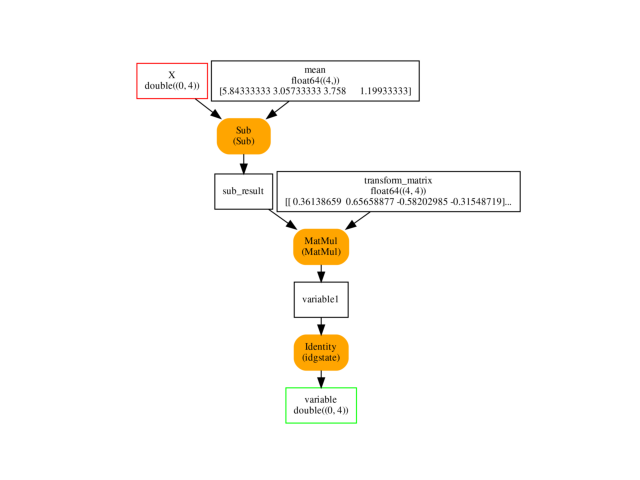Note
Click here to download the full example code
Implement a new converter using other converters¶
In many cases, a custom models leverages existing models which already have an associated converter. To convert this patchwork, existing converters must be called. This example shows how to do that. Example Implement a new converter can be rewritten by using a PCA. We could then reuse the converter associated to this model.
Custom model¶
Let’s implement a simple custom model using
scikit-learn API. The model is preprocessing
which decorrelates correlated random variables.
If X is a matrix of features,
is the covariance matrix. We compute
.
from mlprodict.onnxrt import OnnxInference
from pyquickhelper.helpgen.graphviz_helper import plot_graphviz
import pickle
from io import BytesIO
import numpy
from numpy.testing import assert_almost_equal
from onnxruntime import InferenceSession
from sklearn.base import TransformerMixin, BaseEstimator
from sklearn.datasets import load_iris
from sklearn.decomposition import PCA
from skl2onnx import update_registered_converter
from skl2onnx.algebra.onnx_operator import OnnxSubEstimator
from skl2onnx import to_onnx
class DecorrelateTransformer(TransformerMixin, BaseEstimator):
"""
Decorrelates correlated gaussian features.
:param alpha: avoids non inversible matrices
by adding *alpha* identity matrix
*Attributes*
* `self.mean_`: average
* `self.coef_`: square root of the coveriance matrix
"""
def __init__(self, alpha=0.):
BaseEstimator.__init__(self)
TransformerMixin.__init__(self)
self.alpha = alpha
def fit(self, X, y=None, sample_weights=None):
self.pca_ = PCA(X.shape[1])
self.pca_.fit(X)
return self
def transform(self, X):
return self.pca_.transform(X)
def test_decorrelate_transformer():
data = load_iris()
X = data.data
dec = DecorrelateTransformer()
dec.fit(X)
pred = dec.transform(X)
cov = pred.T @ pred
for i in range(cov.shape[0]):
cov[i, i] = 1.
assert_almost_equal(numpy.identity(4), cov)
st = BytesIO()
pickle.dump(dec, st)
dec2 = pickle.load(BytesIO(st.getvalue()))
assert_almost_equal(dec.transform(X), dec2.transform(X))
test_decorrelate_transformer()
data = load_iris()
X = data.data
dec = DecorrelateTransformer()
dec.fit(X)
pred = dec.transform(X[:5])
print(pred)
Out:
[[-2.68412563e+00 3.19397247e-01 -2.79148276e-02 -2.26243707e-03]
[-2.71414169e+00 -1.77001225e-01 -2.10464272e-01 -9.90265503e-02]
[-2.88899057e+00 -1.44949426e-01 1.79002563e-02 -1.99683897e-02]
[-2.74534286e+00 -3.18298979e-01 3.15593736e-02 7.55758166e-02]
[-2.72871654e+00 3.26754513e-01 9.00792406e-02 6.12585926e-02]]
Conversion into ONNX¶
Let’s try to convert it and see what happens.
try:
to_onnx(dec, X.astype(numpy.float32))
except Exception as e:
print(e)
Out:
Unable to find a shape calculator for type '<class '__main__.DecorrelateTransformer'>'.
It usually means the pipeline being converted contains a
transformer or a predictor with no corresponding converter
implemented in sklearn-onnx. If the converted is implemented
in another library, you need to register
the converted so that it can be used by sklearn-onnx (function
update_registered_converter). If the model is not yet covered
by sklearn-onnx, you may raise an issue to
https://github.com/onnx/sklearn-onnx/issues
to get the converter implemented or even contribute to the
project. If the model is a custom model, a new converter must
be implemented. Examples can be found in the gallery.
This error means there is no converter associated to DecorrelateTransformer. Let’s do it. It requires to implement the two following functions, a shape calculator and a converter with the same signature as below. First the shape calculator. We retrieve the input type add tells the output type has the same type, the same number of rows and a specific number of columns.
def decorrelate_transformer_shape_calculator(operator):
op = operator.raw_operator
input_type = operator.inputs[0].type.__class__
input_dim = operator.inputs[0].type.shape[0]
output_type = input_type([input_dim, op.pca_.components_.shape[1]])
operator.outputs[0].type = output_type
The converter. One thing we need to pay attention to is the target opset. This information is important to make sure that every node is defined following the specifications of that opset.
def decorrelate_transformer_converter(scope, operator, container):
op = operator.raw_operator
opv = container.target_opset
out = operator.outputs
# We retrieve the unique input.
X = operator.inputs[0]
# We tell in ONNX language how to compute the unique output.
# op_version=opv tells which opset is requested
Y = OnnxSubEstimator(op.pca_, X, op_version=opv, output_names=out[:1])
Y.add_to(scope, container)
We need to let skl2onnx know about the new converter.
update_registered_converter(
DecorrelateTransformer, "SklearnDecorrelateTransformer",
decorrelate_transformer_shape_calculator,
decorrelate_transformer_converter)
onx = to_onnx(dec, X.astype(numpy.float32))
sess = InferenceSession(onx.SerializeToString(),
providers=['CPUExecutionProvider'])
exp = dec.transform(X.astype(numpy.float32))
got = sess.run(None, {'X': X.astype(numpy.float32)})[0]
def diff(p1, p2):
p1 = p1.ravel()
p2 = p2.ravel()
d = numpy.abs(p2 - p1)
return d.max(), (d / numpy.abs(p1)).max()
print(diff(exp, got))
Out:
(3.8700562665638927e-07, 0.0008087741270943213)
Let’s check it works as well with double.
onx = to_onnx(dec, X.astype(numpy.float64))
sess = InferenceSession(onx.SerializeToString(),
providers=['CPUExecutionProvider'])
exp = dec.transform(X.astype(numpy.float64))
got = sess.run(None, {'X': X.astype(numpy.float64)})[0]
print(diff(exp, got))
Out:
(2.220446049250313e-16, 1.168076932317175e-16)
The differences are smaller with double as expected.
Final graph¶
oinf = OnnxInference(onx)
ax = plot_graphviz(oinf.to_dot())
ax.get_xaxis().set_visible(False)
ax.get_yaxis().set_visible(False)

Total running time of the script: ( 0 minutes 1.654 seconds)